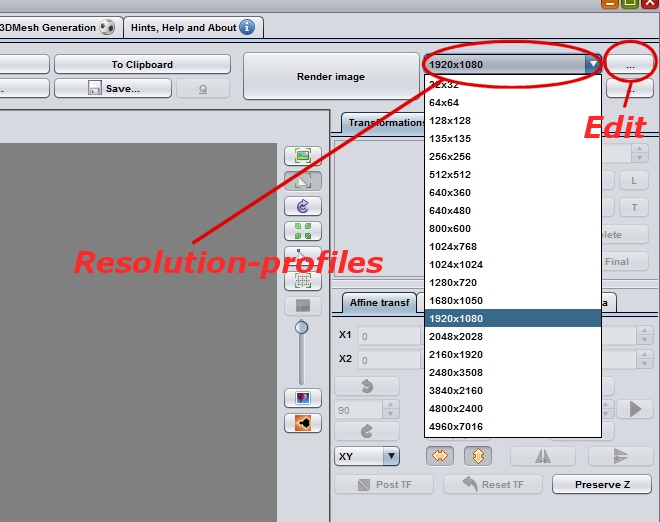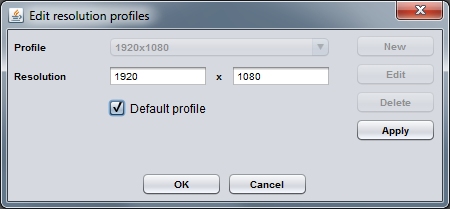Difference between revisions of "Manual Flame Fractals"
(→Defining own resolution profiles) |
(→Defining own resolution profiles) |
||
| Line 18: | Line 18: | ||
There are the following options: | There are the following options: | ||
#'''Resolution''': width and height in pixels | #'''Resolution''': width and height in pixels | ||
| − | #'''Default''': Can only selected by one profile and defines the profile which is automatically selected at startup | + | #'''Default profile''': Can only selected by one profile and defines the profile which is automatically selected at startup |
[[File:Flames_edit_resolution_profile.jpg]] | [[File:Flames_edit_resolution_profile.jpg]] | ||
Revision as of 23:15, 6 March 2015
Contents
Rendering
The final process to generate an image from a flame is called rendering. There are various parameters which affect the quality of your final image and there are even different renderers. Simply spoken, the renderering works that way that the result is the better the longer you render, i. e. the more samples are generated. So you must always find a tradeoff between render-time and quality.
Resolution profiles
To specify the size of rendered images in JWildfire you use resolution-profiles. I .e., a resolution-profile (currently) defines width and height of an images.
There are some predefined resolution-profiles, but you can edit them and define your own. This set of resolution-profiles is accessable in all programm-parts which work with image-sizes.
Defining own resolution profiles
In JWildfire there is virtually no limit on render-size, and you can define any number of resolution-profiles at any size. But, of course, the larger the render-resolution, the more memory is needed.
To define or edit a resolution-profile, enter the main flame-editor and head out for the list-boxes in the right upper area.

There are the following options:
- Resolution: width and height in pixels
- Default profile: Can only selected by one profile and defines the profile which is automatically selected at startup
Quality profiles
The different renderers
Whats affects render time?
Scripts
Scripts are a very powerful and flexible way for users to extend the software. They are written in the Java programming language and are not compatible with scripts known from the Apophysis software (which are written in the Delphi-dialect of pascal)
Even if most available scripts are used to create (random) flames, they are not restricted to create flames. You could also create a calculator or anything else you can imagine.
How do scripts work
JWildfire uses it's integrated Java-compiler to compile the scripts on-the-fly into executable code. This means that could also perform serious calculations in your scripts, because they are fast. And you may use the common Java-libraries and all libraries which are part of JWildfire.
How to use existing scripts from other users
Create a script-folder
In order to work with scripts, you have to first to create a folder were your scripts are stored. As with all of your own data, this folder should be OUTSIDE of the JWildfire folder. So, if you remove/update the JWildfire software, your data is always kept safe. If you have no idea how to name it, you can just create a folder "D:\JWildfire-Data\scripts"
Tell the software about your script-folder
After creating the folder you must enter it's complete path into the Preferences. So, open the Preferences-window from within the main window-menu and locate the property tinaJWFScriptPath. Copy the script path, in this example "D:\JWildfire-Data\scripts". Double-click at the row with the parameter in the 2nd column, so that you can enter text. Paste the script-path and press <ENTER> and press the Save and Close-button
Import the scripts
To import a script just extract the *.zip-file to your script-folder so that the *.jwscript and *.txt-files are directly located into the script-folder (without sub-folder). Example: If you have downloaded a script "butterfly.zip", it should contain two files "butterfly.jwfscript" and "butterfly.txt". Copy this two files directly in the script-folder.
Press the Rescan-button on the Script-tab to refresh the script-view inside of the software.
In the example you should then see a new item "butterfly"
How to start a script
Start from within the script-view
Just select the script in your script-view and press the Run-button to execute a script
Create a custom button for the script
You can also create buttons for easy executing of your favourite scripts
To add a button just select the desired script in the Script-view and press the Add macro button-button. You will see a new button you may click to execute your script at any time.
You can customize or remove this button on the Macro buttons-tab at the Scripts-tab
